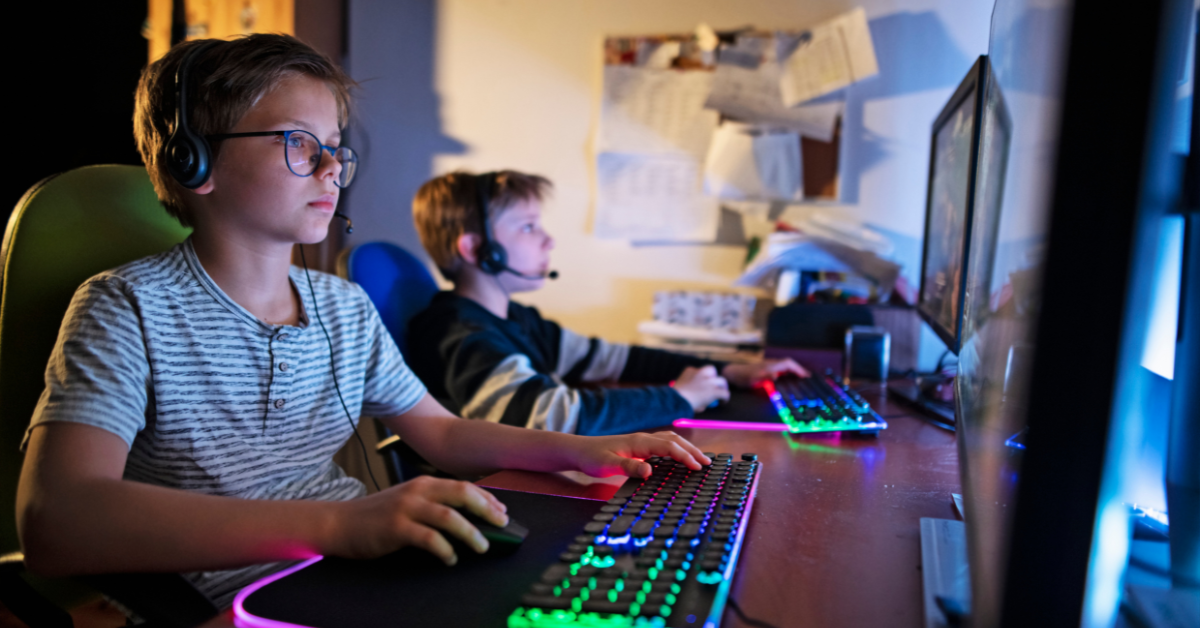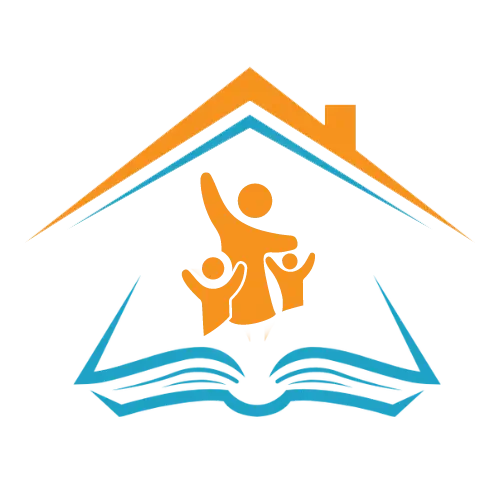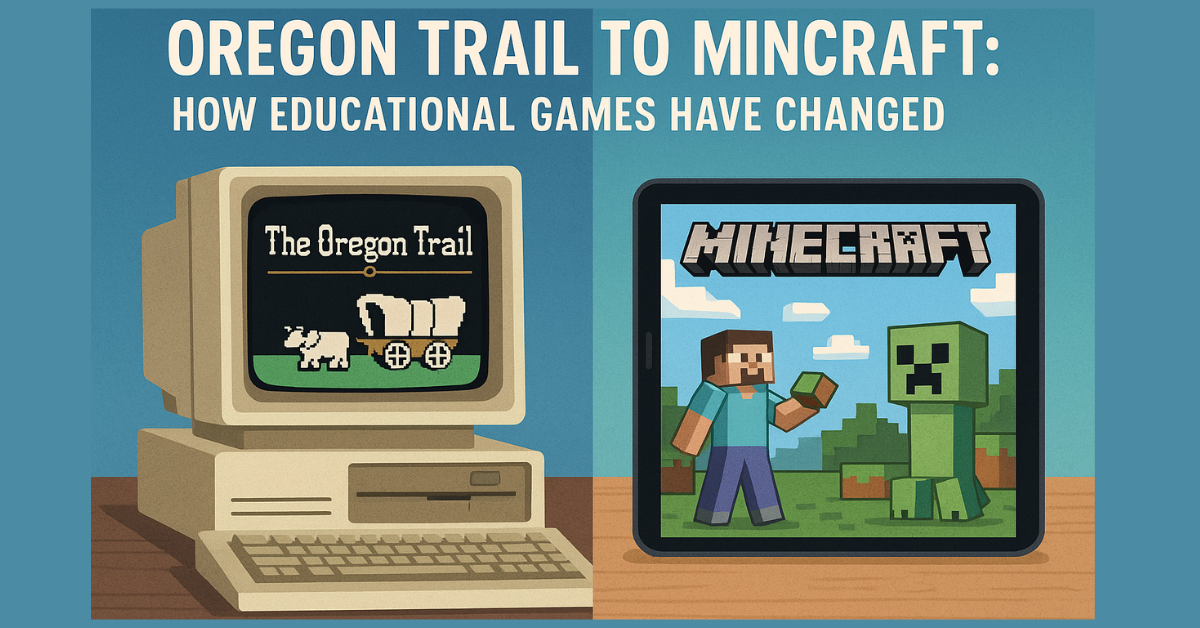If you grew up in the ’80s or ’90s, chances are you remember gathering around a chunky classroom computer, sliding in a floppy disk, and setting off on the adventure of a lifetime: The Oregon Trail. You named your wagon party, stocked up on supplies, and braced yourself for dysentery.
It wasn’t flashy, but it was unforgettable. That game taught a generation of kids about history, resource management, and consequences—all wrapped up in pixelated graphics and a beeping soundtrack.
Fast forward to today, and kids are learning through digital worlds like Minecraft, Roblox, or interactive apps that are brighter, faster, and more immersive than we ever dreamed possible. But how has the shift from retro computer games to modern digital playgrounds shaped learning? And what does it mean for homeschool parents trying to balance fun and education?
Let’s take a nostalgic journey from Oregon Trail to Minecraft and explore how educational games have changed.
The Early Days: Learning in Pixels
Before sleek apps and high-speed Wi-Fi, educational gaming was simple, often text-based, and a little clunky—but powerful in its own way.
Oregon Trail: The Pioneer of Educational Games
First released in the 1970s and popularized in the ’80s and ’90s, The Oregon Trail wasn’t just a game—it was a classroom staple. It taught kids about 19th-century pioneer life, but it also snuck in lessons about math (budgeting supplies), science (hunting and survival), and history (westward expansion).
And let’s be honest—losing an oxen, crossing a river, or facing an untimely demise from dysentery left an impression you didn’t forget.
Other Classics from the Retro Era
- Number Munchers – Math drills disguised as a grid-based adventure.
- Where in the World Is Carmen Sandiego? – Geography, history, and deduction skills rolled into a mystery hunt.
- Math Blaster – Space-themed math practice with plenty of laser action.
- Reader Rabbit – Early literacy skills through fun mini-games.
These games weren’t visually stunning, but they were engaging enough to keep kids hooked—and they laid the foundation for blending play with education.

Today’s Digital Worlds: Immersive and Endless
Fast forward to now, and educational games are a whole new universe. Instead of text on a screen, kids step into interactive 3D worlds where creativity and problem-solving take center stage.
Minecraft: The Modern Oregon Trail?
If Oregon Trail was about survival on the frontier, Minecraft is about survival in a digital sandbox. With endless possibilities, kids can build entire civilizations, learn resource management, and even explore STEM concepts through Minecraft: Education Edition.
Schools and homeschool families alike use it to teach everything from coding to chemistry. And unlike Oregon Trail, the “game over” doesn’t necessarily end in dysentery—it’s a chance to rebuild, adapt, and try again.
Other Popular Digital Learning Platforms
- Roblox – Encourages kids to build their own games, teaching coding and game design basics.
- Kahoot! – A classroom favorite for quizzes and interactive learning.
- Prodigy Math Game – A role-playing adventure that makes math practice fun.
- Duolingo – Language learning with gamified levels and streaks.
Modern educational games are designed with psychology in mind. They use rewards, levels, and badges to keep kids motivated, mimicking the structure of popular video games while reinforcing learning.
Oregon Trail vs. Minecraft: Key Differences
So how do retro classics compare with today’s digital learning worlds? Let’s break it down:
1. Graphics and Engagement
- Then: Simple, pixelated graphics and text-based choices. The fun came from imagination and decision-making.
- Now: Fully immersive 3D worlds with vibrant visuals and limitless possibilities. Engagement comes from exploration and creativity.
2. Learning Style
- Then: Structured, subject-specific learning (math, reading, history).
- Now: Open-ended, cross-curricular learning that blends STEM, problem-solving, and creativity.
3. Collaboration
- Then: Usually single-player, maybe passing the keyboard around the classroom.
- Now: Multiplayer and collaborative—kids can build, learn, and explore together online.
4. Accessibility
- Then: Limited to school computer labs or clunky home desktops.
- Now: Available on tablets, smartphones, laptops, and even VR headsets.
5. Memory and Impact
- Then: Simpler design, but unforgettable lessons (no millennial ever forgets dysentery).
- Now: Richer worlds, but sometimes fast-paced and overwhelming. Parents may need to guide reflection to ensure deep learning sticks.
Why Educational Games Matter in Homeschooling
Whether you’re nostalgic for floppy disks or navigating Roblox with your kids, one thing remains true: educational games work. They engage kids in ways worksheets and lectures can’t, and they blend play with learning seamlessly.
Here’s why they’re especially powerful for homeschool families:
- Motivation: Kids are more willing to practice math or reading when it feels like a game.
- Adaptability: Games can adjust to a child’s skill level, offering personalized learning.
- Critical Thinking: From solving riddles in Carmen Sandiego to building machines in Minecraft, games require planning and problem-solving.
- Safe Exploration: Virtual worlds let kids test ideas, fail safely, and try again.
- Connection: Multiplayer games allow homeschool kids to interact with friends or siblings in fun, structured ways.
Tips for Homeschool Parents Using Educational Games
It’s easy for kids to get lost in the fun side of gaming, so here are some ways to make sure learning stays at the center:
- Choose games intentionally – Pick ones that align with your homeschool goals (math, reading, coding, history).
- Set limits – Use timers or daily play windows to prevent screen overload.
- Play together – Join in! Watching your child build in Minecraft or solve a mystery in Carmen Sandiego can turn gaming into family learning.
- Connect it to real life – After playing Oregon Trail, read a pioneer history book. After Minecraft, try a hands-on STEM project.
- Encourage reflection – Ask questions: What strategy worked best? What did you learn? What would you try differently next time?
Educational Gaming: From Wagons to Worlds
Educational gaming has come a long way since the days of floppy disks and pixelated oxen. The Oregon Trail gave us lessons in survival and resourcefulness, while Minecraft opens the door to creativity, collaboration, and endless exploration.
Both eras have something valuable to offer. The retro games remind us of the power of simplicity and imagination, while modern digital worlds show us the potential of immersive, hands-on learning.
For homeschool parents, the key is finding balance: blending the nostalgia and structure of the past with the innovation and creativity of today. Whether your child is guiding a wagon party west or building a castle in Minecraft, the lesson is the same—learning can be an adventure.
So go ahead: boot up a retro emulator for some Oregon Trail nostalgia, then switch gears to Minecraft Education for a modern twist. Because in the end, it’s not about the pixels or the graphics—it’s about making learning memorable.





